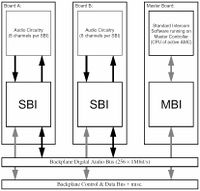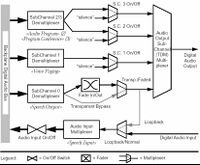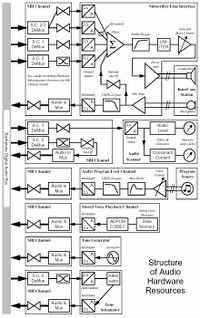AlphaCom Audio Switching Hardware
From Zenitel Wiki
This article contains a brief overview of the hardware involved in audio switching in an AlphaCom Exchange Module.
Audio Switching Hardware Infrastructure Overview
The first figure below shows the core elements of the infrasructure involved in audio switching. (Non-audio elements such as Slave Controllers are not shown. That the Master board also doubles as a Audio Board is not shown here either.) All audio switching is controlled from the software on the Master Controller. It accesses the Audio Switching Control Registers in the SBI through the MBI and the Backplane Data Bus. Each board may have from one to eight SBI’s and each SBI has eight identical “Digital Audio Channels” or “Channels” for short. Audio travels through the system as 1Mbit/s line-switched digital signals. The backplane has 16 bus lines, each with 16 timeslots, giving a total switching capacity of 256 one-way audio signals per Exchange Module. The default modulation is Stentofon-modified 1Msample/s Σ∆-modulation.(Audio with different modulations and synchronous or asynchronous data may be line-switched through the same infrastructure as well.) <br\><br\>
The structure of each SBI Digital Audio Channel is shown in the figure below. Each of the SubChannel Time/Space Demultiplexers pick out one of the 256 possible signals on the Backplane Digital Audio Bus. The third demultiplexed signal is splitted into 2 signals on the Digital Audio Output. Each of the resulting 4 SubChannels have its separate On/Off control. The Primary (#0) SubChannel has a Fast (≈8ms) Fader instead of a direct switch to provide click-free switching. (The Fader may be bypassed in order to transparently forward audio with different modulations or data by sett ing theTransparent/ Faded Mode switch to Transparent). The Digital Audio Output is 8-way time division (TDM) multiplexed, providing the 4 available Digital Audio Output SubChannels plus 4 channels reserved for future use. The Digital Audio Input is non-multiplexed. It is put onto the Backplane Digital Audio Bus by the Audio Input Time/Space Multiplexer if and when the Audio Input On/Off Switch is set to On. It is possible by setting the Loopback/Normal to Loopback to feed the SubChannel 0 Signal back onto the Backplane Digital Audio Bus.(In order to provide a common feeding/fading point for multiple destinations and/or to provide click-free fading to signals destined for faderless subchannels.) <br\><br\> Sometimes you will see the subchannels identified by their primary use instead of their number. These names are those that look like this in the figure above: «Speech Output». Each of the SubChannel Demultiplexers and the Audio Input Multiplexer is controlled by a value in a separate 8-bit Timeslot Register selecting which Backplane Timeslot to listen to or to drive. Each of the On/Off (and Fade In/Out) controls is controlled by a separate bit in a common Channel Control Register. The two mode settings (Transparent/Faded and Loopback/Normal) are controlled by two bits of the Channel Mode Register.
Structure of Audio Hardware Resources
The figure below shows the internal structure of all the Audio Hardware Resources. Unused elements, Non-Audio elements and Non-Functional elements are omitted to improve readability. For example the Subchannel Multiplexers and Subchannel Demultiplexers are omitted since they are non-functional and their inclusion would only have decreased clarity and readability. Some minor details are also omitted since they would have confused the big picture more than clarified it. All non-SBI symbols are supplied with names/descriptions. “Amp.” is short for Amplifier. ADC is an acronym for Analog to Digital Conversion. See the «Audio Switching Hardware Infrastructure Overview» section in the «Audio Switching Architecture» part for details on the SBI Channels. If anything still is unclear refer to the System Architecture Descriptions and Hardware Descriptions (and inform the author if you think it should also be better desribed here).



